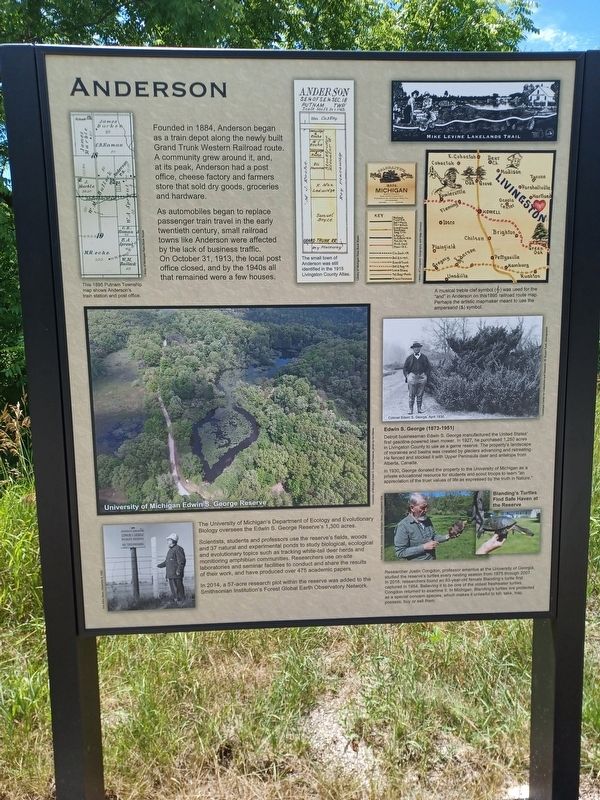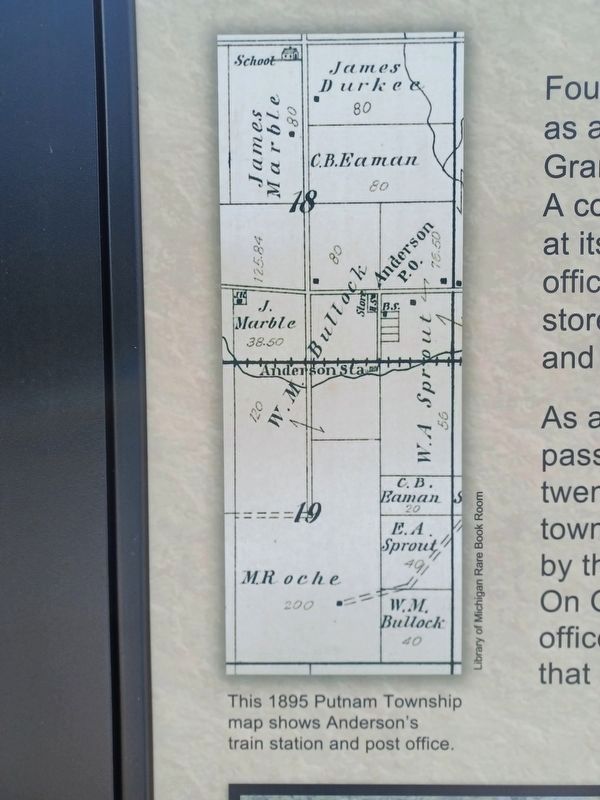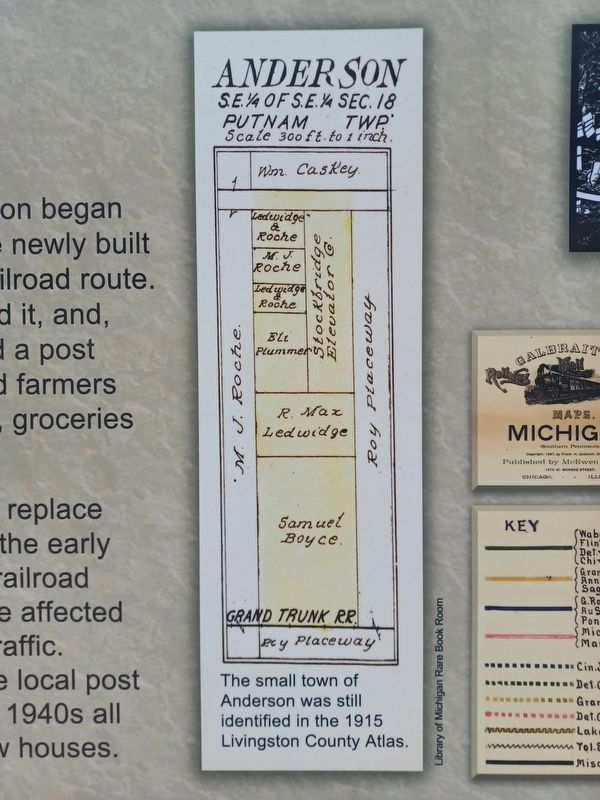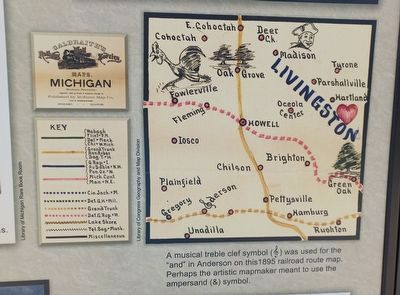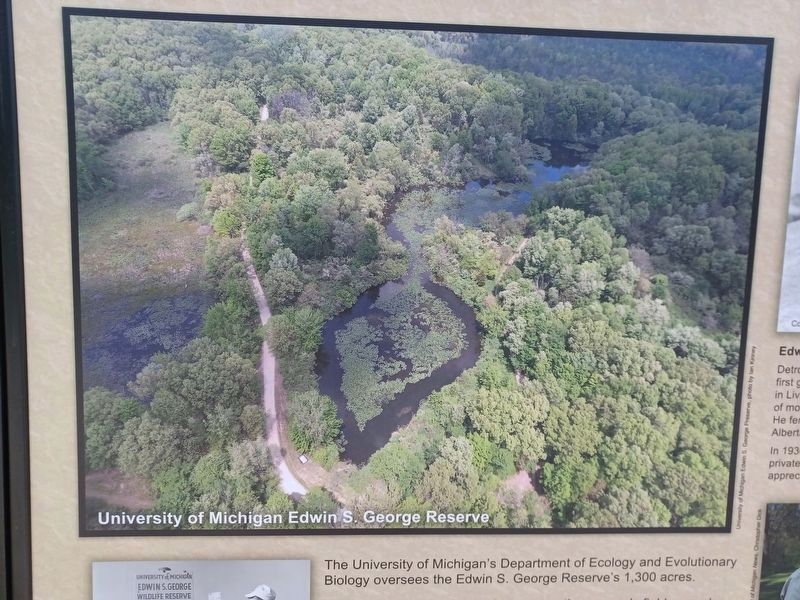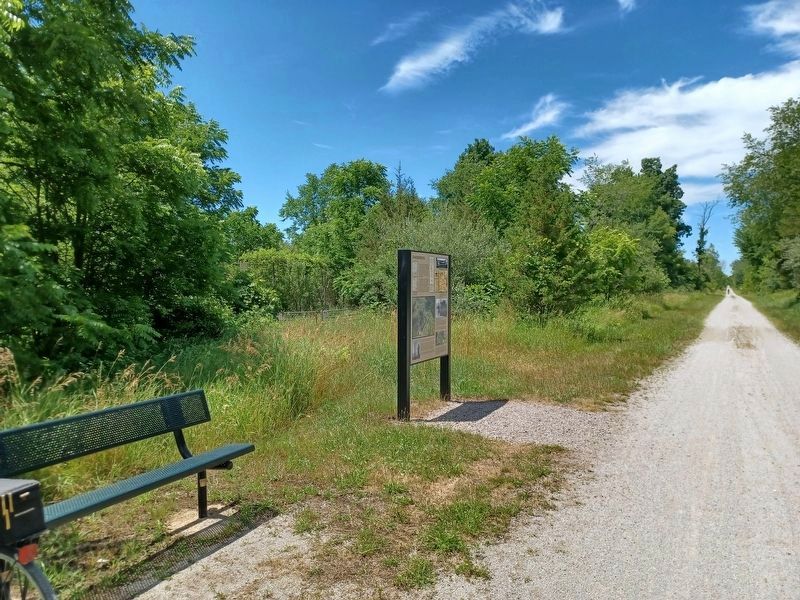Near Pinckney in Livingston County, Michigan — The American Midwest (Great Lakes)
Anderson
Founded in 1884, Anderson began as a train depot along the newly built Grand Trunk Western Railroad route. A community grew around it, and, at its peak, Anderson had a post officce, cheese factory and farmers store that sold dry goods, groceries and hardware.
As automobiles began to replace passenger train travel in the early twentieth century, small railroad towns like Anderson were affected by the lack of business traffic. On October 31, 1913, the local post office closed, and by the 1940s all that remained were a few houses.
Erected 2021 by Mike Levine Lakelands Trail, Michigan History Center, Michigan Department of Natural Resources.
Topics. This historical marker is listed in these topic lists: Animals • Environment • Science & Medicine • Settlements & Settlers. A significant historical date for this entry is October 31, 1913.
Location. 42° 28.048′ N, 84° 0.668′ W. Marker is near Pinckney, Michigan, in Livingston County. Marker is on the Mike Levine Lakelands Trail, about 0.5 mi. west of Kelly Road. Touch for map. Marker is in this post office area: Pinckney MI 48169, United States of America. Touch for directions.
Other nearby markers. At least 8 other markers are within 7 miles of this marker, measured as the crow flies. The Grieving Yard (approx. 2.6 miles away); Pinckney (approx. 3½ miles away); First Presbyterian Church (approx. 3.6 miles away); Unadilla Baseline Cemetery (approx. 3.7 miles away); Plainfield Methodist Church (approx. 5½ miles away); Park Lawn Beach (approx. 5.6 miles away); North Lake Methodist Church (approx. 5.7 miles away); History of Lyndon Township (approx. 6.3 miles away).
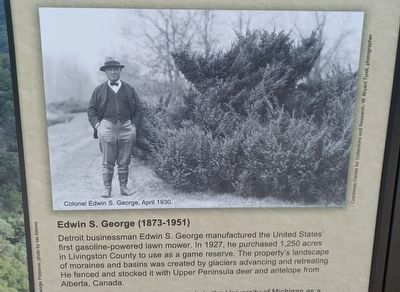
Cranbrook Center for Collections and Research, W. Bryant Tyrell, photographer
6. Anderson Marker middle right image
Edwin S. George (1873-1951)
Detroit businessman Edwin S. George manufactured the United States' first gasoline-powered lawn mower. In 1927, he purchased 1,250 acres in Livingston County to use as a game reserve. The property's landscape of moraines and basins was created by glaciers advancing and retreating. He fenced and stocked it with Upper Peninsula deer and antelope from Alberta, Canada.
In 1930, George donated the property to the University of Michigan as a private educational resource for students and scout troops to learn "an appreciation of the truer values of life as expressed by the truth in Nature."
Detroit businessman Edwin S. George manufactured the United States' first gasoline-powered lawn mower. In 1927, he purchased 1,250 acres in Livingston County to use as a game reserve. The property's landscape of moraines and basins was created by glaciers advancing and retreating. He fenced and stocked it with Upper Peninsula deer and antelope from Alberta, Canada.
In 1930, George donated the property to the University of Michigan as a private educational resource for students and scout troops to learn "an appreciation of the truer values of life as expressed by the truth in Nature."
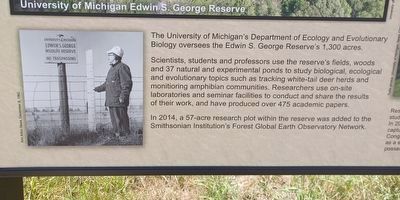
Photographed By Ann Arbor News, December 8, 1962
7. Anderson Marker lower left image
The University of Michigan's Department of Ecology and Evolutionary Biology oversees the Edwin S. George Reserve's 1,300 acres.
Scientists, students and professors use the reserve's fields, woods and 37 natural and experimental ponds to study biological, ecological and evolutionary topics such as tracking white-tail deer herds and monitoring amphibian communities. Researchers use on-site laboratories and seminar facilities to conduct and share the results of their work, and have produced over 475 academic papers.
In 2014, a 57-acre research plot within the reserve was added to the Smithsonian Institution's Forest Global Earth Observatory Network.
Scientists, students and professors use the reserve's fields, woods and 37 natural and experimental ponds to study biological, ecological and evolutionary topics such as tracking white-tail deer herds and monitoring amphibian communities. Researchers use on-site laboratories and seminar facilities to conduct and share the results of their work, and have produced over 475 academic papers.
In 2014, a 57-acre research plot within the reserve was added to the Smithsonian Institution's Forest Global Earth Observatory Network.
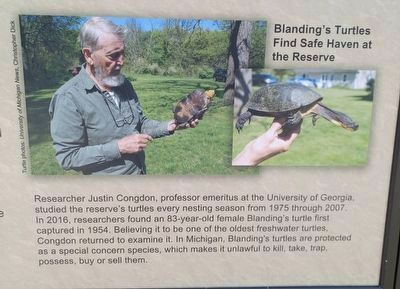
Photographed By Turtle photos: University of Michigan News, Christopher Dick
8. Anderson Marker bottom right image
Blanding's Turtles Find Safe Haven at the Reserve
Researcher Justin Congdon, professor emeritus at the University of Georgia, studied the reserve's turtles every nesting season from 1975 through 2007. In 2016, researchers found an 83-year-old female Blanding's turtle first captured in 1954. Believing it to be one of the oldest freshwater turtles, Congdon returned to examine it. In Michigan, Blanding's turtles are protected as a special concern species, which makes it unlawful to kill, take, trap, possess, buy or sell them.
Researcher Justin Congdon, professor emeritus at the University of Georgia, studied the reserve's turtles every nesting season from 1975 through 2007. In 2016, researchers found an 83-year-old female Blanding's turtle first captured in 1954. Believing it to be one of the oldest freshwater turtles, Congdon returned to examine it. In Michigan, Blanding's turtles are protected as a special concern species, which makes it unlawful to kill, take, trap, possess, buy or sell them.
Credits. This page was last revised on May 1, 2023. It was originally submitted on July 21, 2022, by Joel Seewald of Madison Heights, Michigan. This page has been viewed 127 times since then and 28 times this year. Photos: 1, 2, 3, 4, 5, 6, 7, 8, 9. submitted on July 21, 2022, by Joel Seewald of Madison Heights, Michigan.
